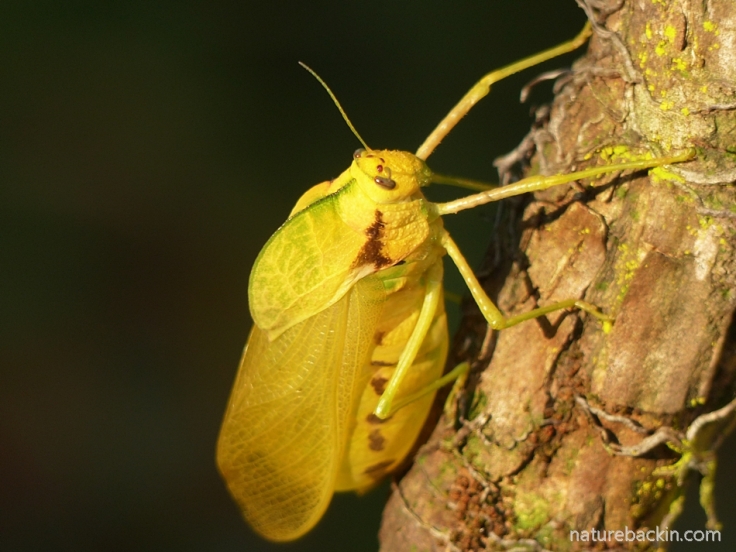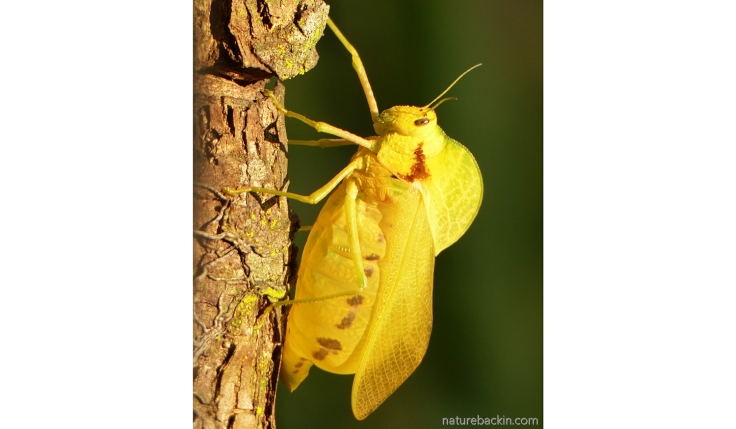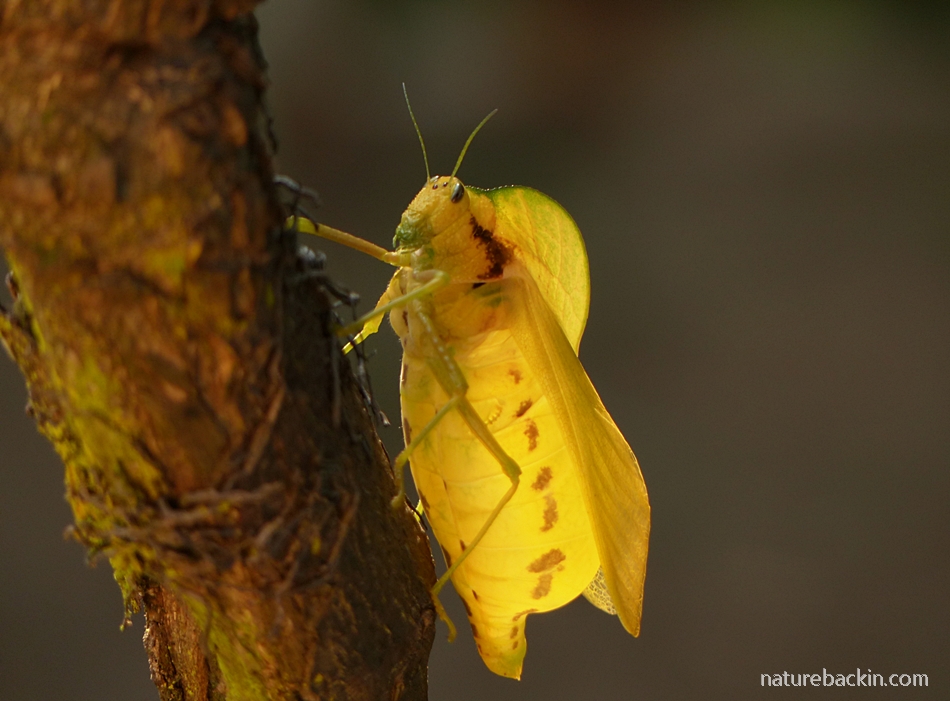Perhaps because Bladder Grasshoppers are active at night, they are heard rather than seen. The call of the male Bladder Grasshopper, something between a bleat, a shriek and a croak, is alarmingly loud.
As I so seldom see them, I was surprised to see this Bladder Grasshopper perched on the stem of a small tree late one afternoon. Its attractive lemon-yellow colour was beautifully backlit by the light of the setting sun.
Initially I thought it was a Katydid or Bush-cricket, but I later learnt that whereas Katydids characteristically have long filament-like antennae, Bladder Grasshoppers have short antennae and, hence, are part of the group referred to as short-horned grasshoppers. The family name of Bladder Grasshoppers is Pneumoridae.

Female Bladder Grasshoppers do not have wings, and therefore I deduce that the one I photographed is a male as the wings are well developed. This male has an inflated abdomen. Interestingly, in some species of Bladder Grasshoppers there are two forms: in one form the males have inflated abdomens, and in the other the abdomens are not inflated
Although in both forms mature males call to attract females, the extremely loud and raucous call is made by males with inflated abdomens, which amplify the sound. A male Bladder Grasshopper makes the sound by stridulating, rubbing rasps on its hind legs over ridges on the abdomen to emit his ear-splitting calls. If not masked by other sounds, the nocturnal call of a male Bladder Grasshopper can be heard over a distance of nearly two kilometres (1¼ miles). This is the longest calling distance recorded for an insect.

In this photo, the ridges or knobs on the abdomen, over which the male rubs rasps on his hind legs when stridulating, can be seen
When the male attracts a female she responds with relatively soft calls. The male approaches and they call and respond in duet and in so doing pair bond prior to mating. Females lay eggs in pods that are buried beneath the surface of the soil. Hatchlings are small and wingless and are referred to as nymphs. At successive stages of their development they moult (shed their skins). Grasshopper species moult 5 or 6 times before reaching their adult form.

Although a nymph and not yet an adult, this Katydid shows the long filament antennae and long back legs in contrast to the short antennae and hind legs of the Bladder Grasshopper
Bladder Grasshoppers (Pneumoridae) occur mostly in southern Africa and mostly in the coastal regions, but some species occur in the eastern coastal regions of Africa as far north as Uganda. The largest genus is Bullacris, represented by the grasshopper in this photograph. Mostly they are green in colour but there is quite a bit of colour variation, including the yellow with darker brown patches as seen in the individual I photographed. I think it is likely to be a Bullacris membracioides, a species that occurs in KwaZulu-Natal.

Sources: Donelson, Nathan C., Smith, Adam R. & Van Staaden, Moira J. 2008. Variation in adult longevity in a polymorphic grasshopper species. Journal of Orthoptera Research 17(2): 270-282; Wikipedia. 2018. Pneumoridae. https://en.wikipedia.org/wiki/Pneumoridae; Van Staaden, Moira J. & Römer, Heiner. 1997. Sexual signalling in Bladder Grasshoppers: Tactical design for maximising calling range. Journal of Experimental Biology 200, 2597-2608.
Posted by Carol









December 29, 2020 at 12:18 pm
For the past couple of months we’ve been listening to this shrieking noise at night coming from different directions and thinking it’s a Nightjar bird. Eventually found this large green grasshopper sitting on our door blinds and every so often would send out this piercing shriek, followed by a few muted calls from his female harem.
Fascinating reading the above research, thank you.
LikeLiked by 1 person
January 1, 2021 at 10:46 am
Thank you Pen. It is astonishing isn’t it that such a small creature can emit such a loud and piercing shriek. How interesting that you also heard the females responding. I really appreciate you getting in touch.
LikeLike
September 23, 2018 at 3:15 am
Truly fascinating information I wouldn’t have wanted to miss while I was on holiday! Thanks!
LikeLiked by 1 person
September 25, 2018 at 5:23 am
Thanks Gunta. Hope the holiday has been good.
LikeLike
September 21, 2018 at 12:07 pm
Such a beauty! I know grashoppers with wonderful colourful wings, but I have never seen a completely yellow one. Thanks for showing, Carol!
LikeLiked by 1 person
September 21, 2018 at 6:57 pm
Yes it is a lovely and unusual colour. Thanks Simone.
LikeLiked by 1 person
September 21, 2018 at 5:26 am
I’m trying to imagine the call of this creature. Sleeping while he’s around must be an issue. Fascinating post.
LikeLiked by 1 person
September 21, 2018 at 6:56 pm
Hard to describe the rather piercing intensity of the call that can be a little unnerving. Fortunately they move on and don’t usually stay in one place for long.
LikeLiked by 1 person
September 21, 2018 at 5:00 am
and here I thought it was Merle shrieking in her sleep 😉
LikeLiked by 1 person
September 21, 2018 at 6:53 pm
🙂 Glad to be of assistance on that one! 🙂
LikeLike
September 21, 2018 at 4:50 am
What a gorgeous color. Seems unfair to be saddled with a name like ‘Bladder Grasshopper.’ It would be interesting to hear a recording of it in full voice.
LikeLiked by 1 person
September 21, 2018 at 6:50 pm
A more poetic name would be nice. Maybe I should set myself the task of trying to record it this summer, though its unpredictable late nocturnal habits and that it doesn’t stick around for long when calling doesn’t make that easy.
LikeLiked by 1 person
September 21, 2018 at 3:48 am
Thank you Carol for a most interesting read, marvelously illustrated by your excellent photographs!
LikeLiked by 1 person
September 21, 2018 at 6:47 pm
Thanks so much for your kind comment.
LikeLiked by 1 person
September 21, 2018 at 2:55 am
Another fascinating read!
LikeLiked by 1 person
September 21, 2018 at 6:39 pm
Thanks Anne. I found them to be fascinating too.
LikeLike
September 21, 2018 at 12:52 am
amazing!
LikeLiked by 1 person
September 21, 2018 at 6:37 pm
Thanks Liz. I was just going to use one photo as a photo find, but when I started reading about them I thought they were interesting enough for a post.
LikeLiked by 1 person
September 21, 2018 at 12:04 am
I have never seen a grasshopper of such a bright lemon color.
Perhaps the females give in to the males to stop all the shouting! (only kidding)
LikeLiked by 1 person
September 21, 2018 at 6:35 pm
Method in the madness!
LikeLiked by 1 person
September 20, 2018 at 11:34 pm
Wonderful sighting. Terrific photos!
LikeLiked by 1 person
September 21, 2018 at 6:34 pm
Thanks so much Belinda. I have not seen one since.
LikeLiked by 1 person
September 20, 2018 at 9:54 pm
What a find. Never heard of this species before. Well done , you!
LikeLiked by 1 person
September 21, 2018 at 6:34 pm
Thanks Ark. It was lucky to see him. As they tend to be more coastal or in adjacent areas I doubt they occur in your neck of the woods.
LikeLiked by 1 person
September 20, 2018 at 9:30 pm
It is amazing that no one has recorded this sound and uploaded it on the net. I looked, but couldn’t find one. I’m curious to hear its call.
LikeLiked by 1 person
September 21, 2018 at 6:32 pm
Yes, I looked for a recording too with no luck! Maybe I’ll listen out for them more conscientiously this summer!
LikeLiked by 1 person
September 20, 2018 at 9:20 pm
He’s a very interesting colour. Not very well camouflaged, it would seem.
LikeLiked by 1 person
September 21, 2018 at 6:31 pm
Yes he is conspicuous here, but perhaps in a more leafy context he would be harder to spot.
LikeLike